Thermaltake Muse R-Duo: External RAID
by Dave Robinet on December 14, 2007 2:00 AM EST- Posted in
- Storage
PCMark Vantage
PCMark Vantage is the latest benchmark available from Futuremark, and requires on Windows Vista. Similar to the venerable PCMark05 in its makeup, Vantage modernizes the criteria and test methodology to reflect what users may encounter when running the most current Windows operating system. For the HD test suite, Futuremark breaks the tests down as:
- Windows Defender: Windows Defender performs a scan operation, resulting in a read-intensive (99.5% read, 0.5% write) benchmark reflecting a common task in Windows Vista.
- Gaming Performance: Measures streaming performance using actual game mechanics found in Alan Wake. This test is nearly all read (99.95% read, 0.05% write) in nature.
- Windows Photo Gallery: Windows Photo Gallery imports a large collection of images. This is the first of the tests which bring write performance into account in a meaningful way, with a roughly 84% read, 16% write ratio.
- Windows Vista Start-up: Simulates Windows Vista start-up operations, producing a test that breaks down to roughly 85% read and 15% write operations.
- Windows Movie Maker: This is the first Vantage test that comes close to equally dividing read and write operations (54% read, 46% write). It tests concurrent video performance for video read and skip performance, as well as video write operations.
- Windows Media Center: Performs the following three
tasks, with a result split equally between reading and writing.
- SDTV video playback
- SDTV video streaming to Extender for Windows Media Center
- SDTV video recording
- Windows Media Player: Windows Media Player adds a selection of music. This test reverts to favoring read operations (78% read, 22% write).
- Application Loading: Loads the following applications,
giving a benchmark divided as roughly 87% read, 13% write in nature.
- Microsoft Word 2007
- Adobe Photoshop CS2
- Internet Explorer 7
- Outlook 2007
We run each test five times per drive, producing an average score that we use for comparison in our charts. Our Vista strategy follows the one we're using for Windows XP: Apply only major milestone releases (SP1, SP2, etc.) except when absolutely necessary, and keep drivers updated when required. When a major driver (or OS) version is released, we will go back and re-run previous benchmarks to ensure that the data remains consistent. For our tests, we disable Windows Defender, set the paging file to a static 3.0GB size, and limit the Recycle Bin to 1GB maximum. We also close all desktop widgets.
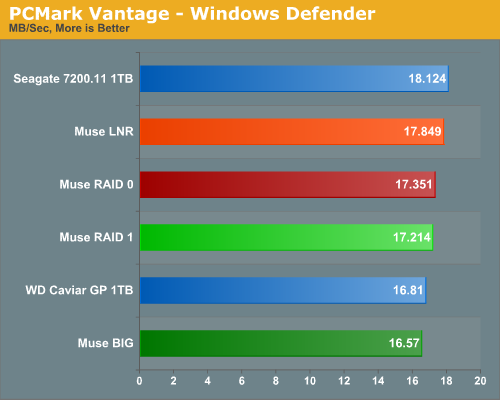
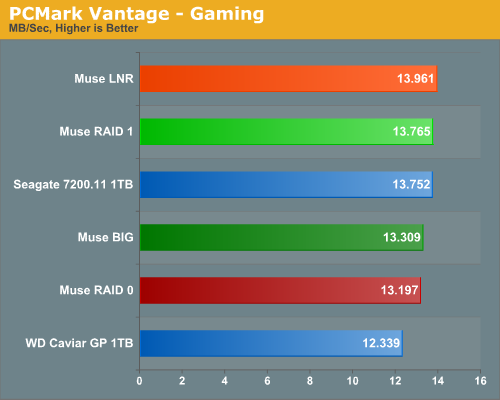
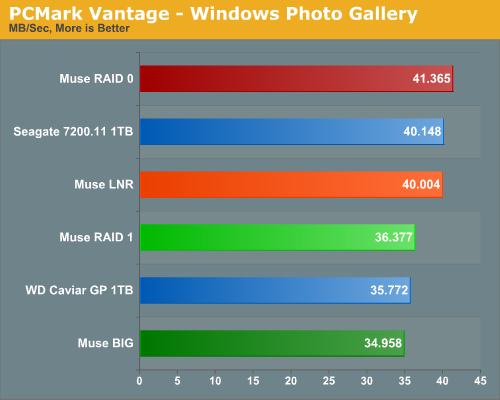
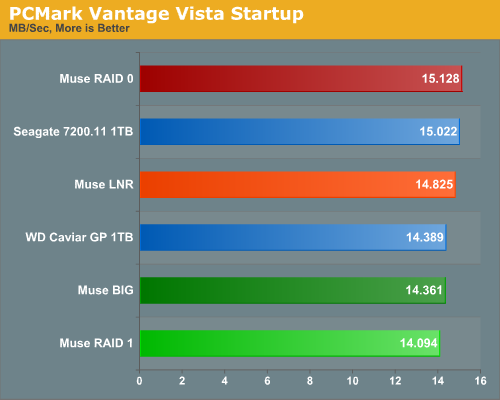
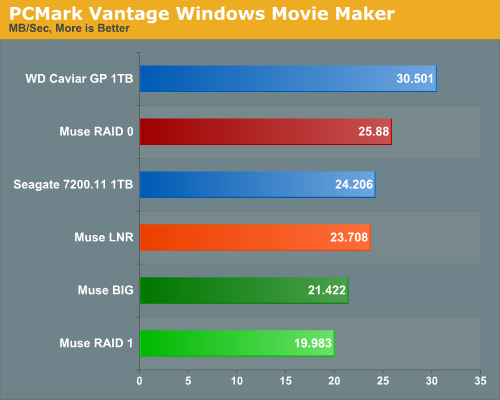
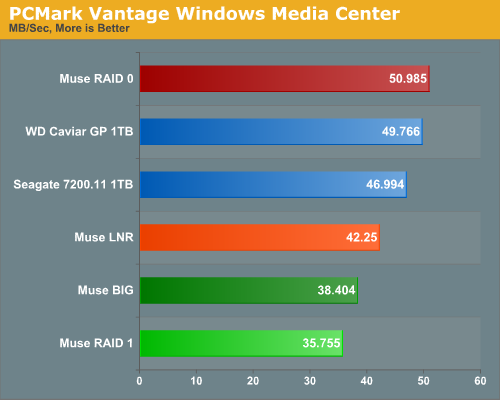
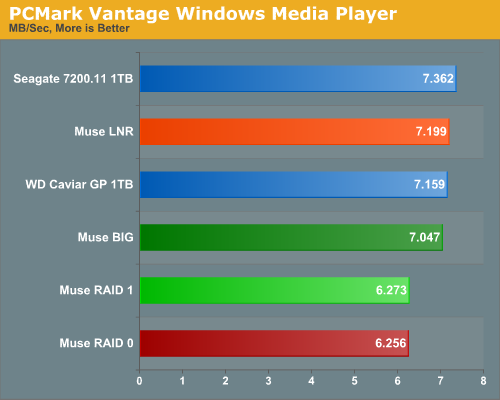
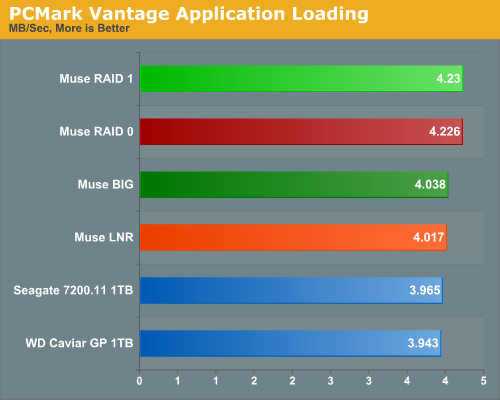
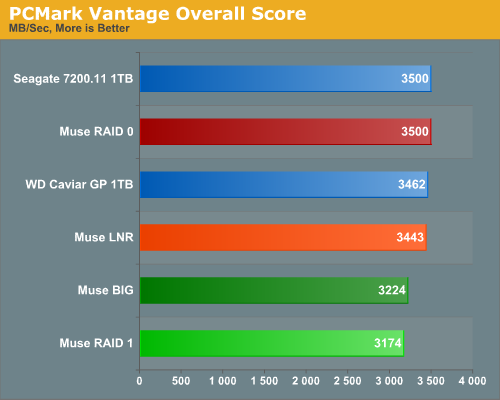
We find more of the same in our Vantage benchmarks. The Muse performs adequately as a single drive enclosure but poorly as a RAID controller. In PCMark Vantage, we don't see many of the really poor Big mode performance issues that we saw under XP, but the results scale more or less the same way.










11 Comments
View All Comments
Zak - Friday, December 14, 2007 - link
I've gone through 4 dual drive enclosures and concluded that anything with fan smaller than 80mm is too loud. They were usually louder than my computer so I don't expect this one to be any better. I've settled for SansDigital 4-drive USB eclosure in JBOD mode. Their 4-drive SATA is also a great value but I couldn't get the included SATA card to work properly neither under OSX nor Windows XP so it went back. But I'd like to see some reviews of SansDigital hardware, they have some nice offerings.Zak
MrPickins - Friday, December 14, 2007 - link
I'm sure I missed it when reading the article, but what type of connection were you using for the benchmarks?I'd assume eSATA, but I'd also like to see how the enclosure performs using the USB interface.
Dave Robinet - Friday, December 14, 2007 - link
Yep - eSATA was used. It's tough to imagine a lot of USB use for this sort of device, to be honest, so that wasn't tested.Thanks a lot for reading!
Magendanz - Friday, December 14, 2007 - link
I believe this unit uses the Silicon Image SiI5744 Storage Processor, which has frequent firmware updates and a decent utility called SteelVine Manager for configuring and monitoring the chipset. I purchased a similar unit called the ONNTO DataWhale from CoolDrives and have been very happy with it. (The DataWhale has removeable drive trays, which I like.)It's interesting to note that the SteelVine products have support for SAFE33 and SAFE50 modes (which split the drives into RAID 1 and BIG partitions) as well as an advanced GUI configuration mode that allows you to configure combined modes manually. On the DataWhale, this was enabled with an internal jumper and I'd expect the Muse also has this. Just pull the jumper and set the DIP switches to SAFE mode, then you can configure to your heart's content using SteelVine Manager.
Note: The latest version of SteelVine Manager requires the latest firmware update, but since SteelVine Manager is required to update the firmware this results in a bit of a Catch 22. Just install an older version of SteelVine Manager, install the firmware update, and then update to the latest version.
Yawgm0th - Friday, December 14, 2007 - link
The definition of RAID 1 listed in the article is not correct. In a standard RAID 1, the drives are mirrored and presented as a single volume to the operating system. However, they will both be accessed simultaneously during all read and write actions. This is why RAID 1 generally results in a substantial increase in read speeds but a slight decrease in write speeds.This is true if you are doing a software RAID, in which case the operating system or RAID software knows to do this, and with a hardware RAID, in which case the controller automatically reads and writes to both drives simultaneously. Anything else is not RAID 1.
The definition listed for RAID 1 in this article describes a behind-the-scenes backup, which is not RAID 1. If this is the case, it ought to be given more mention in the article. One of the biggest benefits to using RAID 1 is not just the high reliability, but the greatly increased read speeds. If the described method is what's in use, then it's a serious flaw in the device.
Dave Robinet - Friday, December 14, 2007 - link
The device does provide true RAID 1 in its normal sense. My choice of words was meant to illustrate the way the end-user sees the device, and it's substantially easier to say "show one device, then use the other".The reality of RAID 1 is that the OS reads from only one drive, so the basic definition is essentially true, though. I'll see about cleaning up the wording to satisfy both clarity and to make it more accurate. Good catch!
yyrkoon - Friday, December 14, 2007 - link
$143 usd is not a terribly large sum of money, but if you look into alternatives, you can get the addonics 2port port Multiplier, and do the same thing for cheaper. Then again, you'd have to either build your own enclosure, or buy one. I wouldnt be surprised if this device in fact uses the addonics port multiplier . . .All the above said, I would have to agree in wondering if RAID really has a place on the desktop(or most workstations and servers for that matter), as there are so many 'better' ways to store data safely without even using RAID in the first place. Database servers storing mission critical data MAY need RAID for an added form of reliability, but probably do not need RAID for performance, as any self respecting database admin is probably using a static ram HDD device, or possibly a large RAM disk(assuming balls out performance is even needed).
I cannot really help but wonder if a software RAID array, on a multiple core system would outperform this device or not. That and the fact with tools such as rsync, and just storing important files on multiple drives wouldn't be as safe, without the hassles/complications that RAID can bring into the big picture. The cost definately would be less . . .
cserwin - Friday, December 14, 2007 - link
I've had to explain to too many family members that their digital photos are gone-baby-gone because they haven't backed them up.I think RAID 1 is critical for digital photos.
ESATA give the advantage of allowing direct management of the photos on the redundant array without any appreciable loss of performance, and it is very portable for upgrades. It is way more functional than USB 'backup' solutions - especially for me, who gets the phone call when my uncle/mom/sister/aunt is having a problem.
yyrkoon - Saturday, December 15, 2007 - link
Sorry, but RAID 1 is not going to magically fix all of everyones problems. What happens if bobby-sue's kid deletes (a la shift delete) all their families image files, or disk corruption creeps onto a single somehow, while mirroring to the second ? Try explaining to a family that their Photos and other data files are bye-bye-gone after you recommended that they spend twice as much in HDDs plus controller(if needed).DeltaCopy:
http://www.aboutmyip.com/AboutMyXApp/DeltaCopy.jsp">http://www.aboutmyip.com/AboutMyXApp/DeltaCopy.jsp
Smart partitioning + DeltaCopy + offsite optical media storage may not be perfect, but is a good bit smarter than just adding another point of failure to a storage syst
Magendanz - Sunday, December 16, 2007 - link
Fortunately, Vista and Windows Server shadow copies prevents data loss in these scenarios.